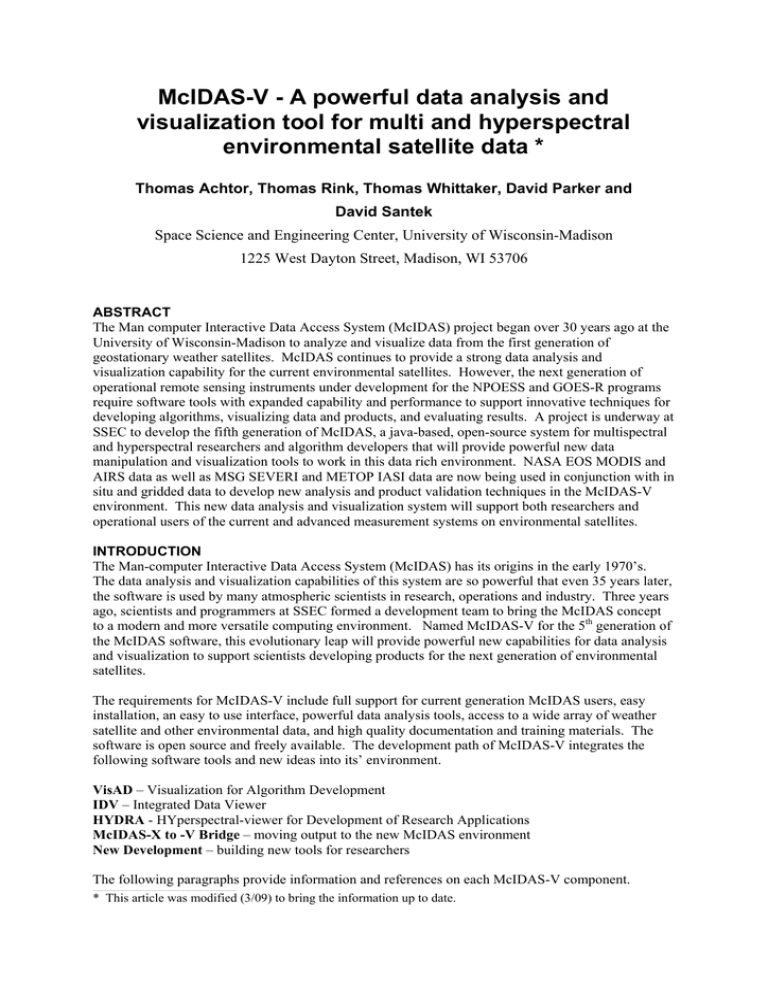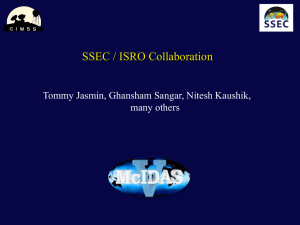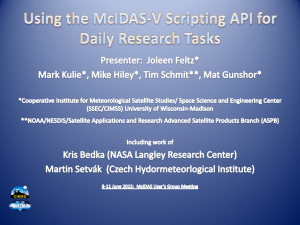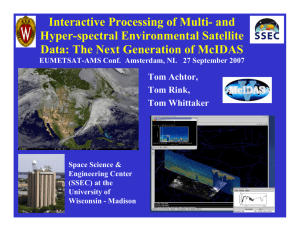McIDAS-V - A powerful data analysis and environmental satellite data *
advertisement

McIDAS-V - A powerful data analysis and visualization tool for multi and hyperspectral environmental satellite data * Thomas Achtor, Thomas Rink, Thomas Whittaker, David Parker and David Santek Space Science and Engineering Center, University of Wisconsin-Madison 1225 West Dayton Street, Madison, WI 53706 ABSTRACT The Man computer Interactive Data Access System (McIDAS) project began over 30 years ago at the University of Wisconsin-Madison to analyze and visualize data from the first generation of geostationary weather satellites. McIDAS continues to provide a strong data analysis and visualization capability for the current environmental satellites. However, the next generation of operational remote sensing instruments under development for the NPOESS and GOES-R programs require software tools with expanded capability and performance to support innovative techniques for developing algorithms, visualizing data and products, and evaluating results. A project is underway at SSEC to develop the fifth generation of McIDAS, a java-based, open-source system for multispectral and hyperspectral researchers and algorithm developers that will provide powerful new data manipulation and visualization tools to work in this data rich environment. NASA EOS MODIS and AIRS data as well as MSG SEVERI and METOP IASI data are now being used in conjunction with in situ and gridded data to develop new analysis and product validation techniques in the McIDAS-V environment. This new data analysis and visualization system will support both researchers and operational users of the current and advanced measurement systems on environmental satellites. INTRODUCTION The Man-computer Interactive Data Access System (McIDAS) has its origins in the early 1970’s. The data analysis and visualization capabilities of this system are so powerful that even 35 years later, the software is used by many atmospheric scientists in research, operations and industry. Three years ago, scientists and programmers at SSEC formed a development team to bring the McIDAS concept to a modern and more versatile computing environment. Named McIDAS-V for the 5th generation of the McIDAS software, this evolutionary leap will provide powerful new capabilities for data analysis and visualization to support scientists developing products for the next generation of environmental satellites. The requirements for McIDAS-V include full support for current generation McIDAS users, easy installation, an easy to use interface, powerful data analysis tools, access to a wide array of weather satellite and other environmental data, and high quality documentation and training materials. The software is open source and freely available. The development path of McIDAS-V integrates the following software tools and new ideas into its’ environment. VisAD – Visualization for Algorithm Development IDV – Integrated Data Viewer HYDRA - HYperspectral-viewer for Development of Research Applications McIDAS-X to -V Bridge – moving output to the new McIDAS environment New Development – building new tools for researchers The following paragraphs provide information and references on each McIDAS-V component. __________________________________________________________________________ * This article was modified (3/09) to bring the information up to date. VisAD The foundation of McIDAS-V is the Visualization for Algorithm Development (VisAD), an open source, Java™ library for building interactive and collaborative data analysis and visualization tools. Developed by Bill Hibbard at UW-Madison/SSEC in the 1990’s, VisAD (http://www.ssec.wisc.edu/~billh/visad.html) is used by a wide variety of scientists and others seeking a powerful data analysis software tool. VisAD combines several important attributes, including * the use of Java for platform independence, * a powerful mathematical data model that embraces virtually any numerical data set * a general display model that supports 2-D and 3-D displays, including multiple data views with direct manipulation * metadata that is integrated into each data object * adapters for multiple data formats (netCDF, HDF-5, FITS, HDF-EOS, McIDAS, Vis5D, etc.) and access to remote data servers through HTTP, FTP, DODS/OPeNDAP, and OPENADDE protocols IDV The Integrated Data Viewer (IDV) is also an open source, Java based software framework developed at Unidata that builds upon the VisAD library to provide a versatile data analysis and visualization toolkit for geoscience data. The IDV brings together the ability to display and work with satellite observations, surface and upper air (radiosonde) observations, gridded data, and radar and profiler data, all within a unified interface. The VisAD/IDV visualization capability provides 3-D views of the atmosphere and allows users to interactively slice and probe the data, creating cross-sections, profiles, animations and value read-outs of multi-dimensional data sets. The software is freely available from Unidata (http://www.unidata.ucar.edu/software/idv/) under the terms of the GNU Lesser General Public License. Figure 1 shows an example of a 3 dimensional rendering of temperature and wind fields over the U.S., while Figure 2 shows an IDV display of data from consecutive overpasses of A-Train instruments MODIS and CALIPSO. Figure 1: IDV rendering of color enhanced 850mb temperature field with 3D wind field greater than 50 kts. Figure 2: Consecutive overpasses from MODIS (base image, color enhanced 11 um channel) and CALIPSO (cross section of lidar cloud backscatter information) HYDRA The Hyperspectral Data Research Application (HYDRA), is a powerful software toolkit developed by SSEC scientists to interrogate multi and hyper spectral satellite data. This tool allows scientists to interactively work with the data, displaying radiance spectra, multi-band imagery, scatter plots and transects. HYDRA was developed for scientist use with aircraft Scanning HIS and EOS AIRS observations, and has also been applied to EOS MODIS, MSG SEVIRI, and METOP IASI data. With the forthcoming NPP/NPOESS and GOES-R programs in the U.S., the HYDRA data interrogation capability is a key feature to add to McIDAS-V. Integration of HYDRA functionality into McIDASV was recently completed. Two examples of HYDRA capabilities are shown below. In Figure 3, the McIDAS-V HYDRA display shows the user has selected a METOP IASI granule (top), and the user has selected two locations on the image to display the full IASI spectra (bottom). The user can move the slider bar on the spectra display to change the image in the top display, thereby allowing powerful user interaction with the entire IASI granule data. Figure 3: McIDAS-V HYDRA displays of a METOP IASI granule window channel image (top) and user selected locations for display of the associated spectra for that field of view. In Figure 4 simulated data from the forthcoming GOES-R Advanced Baseline Imager (ABI) is displayed. The simulated data sets help algorithm developers to develop products for immediate use upon launch and operational deployment of space-based instruments. The left panel of this McIDASV display shows an image from the ABI band 14 (11 um); the center panel shows an image of the differences between band 14 and band 11 (8.5 um) and the right panel shows a scatter plot from the two images; the X-axis is the 11 um brightness temperature and the Y-axis is the difference between band 14 and band 11 (BT14-BT11). Differencing these two channels enables the scientist to separate water cloud from ice cloud. The McIDAS-V user can use the cursor to draw a rubber band box over a region, such as off the west cost of California, to display those pixels in the scatter plot corresponding to those within the box. The user can also draw a rubber band box in the scatter plot and colorize the pixels in the image. This type of data interrogation tools allows users to interactively examine single pixel brightness temperature values for a spectral band or combination of spectral bands. These types of display demonstrate how HYDRA capabilities in McIDAS-V can assist scientists in interrogating data and in developing useful products from current and forthcoming advanced remote sensing instruments. Integrating HYDRA into McIDAS-V will connect this powerful interrogation tool with the many features of the VisAD/IDV. Figure 4: The user has selected two GOES-R ABI spectral bands (left and center) and displayed a scatter plot of the channel differences vs. one channel brightness temperature. The user can identify a group of pixels with the cursor and color enhance those pixels on the imagery or within the scatter plot, thereby identifying specific features from the data. The X TO V BRIDGE An additional and crucial part of the McIDAS-V development is how to support the current McIDASX user community in their migration to McIDAS-V. McIDAS-X, the 4th generation, was created in the early 1990’s to operate on computers running the uni’X’ operating system. McIDAS-X contains over 1 million lines of software, written primarily in the Fortran and C programming languages, that produces a tremendous amount of functionality. Many McIDAS-X users have developed their own software that adds additional functionality to meet their specific needs. In developing McIDAS-V it was evident that all this code and all the functionality could not be rewritten in Java … there would need to be another solution. That solution was a two-way communication between McIDAS-V and a session that was running McIDAS-X. The ‘Bridge’ between -X and -V includes a data chooser that communicates with a McIDAS-X “listener”, providing a bridge between the two systems. Commands initiated from within McIDAS-V are run in McIDAS-X and the results are visualized in the McIDASV environment. This allows sites to continue to use McIDAS-X (including locally developed code) while transitioning to McIDAS-V. The McIDAS-X listener allows outside clients to communicate with a running McIDAS-X session via an arbitrarily assigned network port. Text commands are executed as if they were typed into the McIDAS-X command window and frame contents are returned as either GIF89a formatted images or as raw pixel values. Raw binary data (frame data, words from shared memory and files in MCPATH) can be requested as well. Figure 5 shows a McIDAS-V session running on the top of the screen, and a McIDAS-X session running on the bottom. Using the Listener, a GOES image in native resolution is brought into –V, the projection was changed to account for the GOES E-W oversampling and the Milwaukee Sullivan level 2 radar was overlaid. This figure demonstrates the ability to bring an –X image and data into –V and the powerful new capabilities of –V to add 3-dimensional information. Figure 5: McIDAS-V session on top and McIDAS-X session on bottom. The GOES image from McIDAS-X is acquired by the McIDAS-V session through the “Bridge” and displayed with coordinate transformation and level 2 radar data. SUMMARY AND FUTURE WORK McIDAS-V is a software ensemble containing many features. It builds upon 10+ years of VisAD and several years of IDV development to enhance functionality. McIDAS-V will integrate the multi and hyperspectral satellite data capabilities from HYDRA and allow a two-way dialog with a McIDAS-X session to make available those data and products. On top of these powerful attributes are improved data and server management, and a friendly and user configurable interface. Finally, since the software is freely available and open source, we will add our own and our collaborators improvements to continue to evolve the capabilities of the software. At the annual American Meteorological Society (AMS) meeting in January 2009, a beta version of McIDAS-V was released and demonstrated to the general public. Several new features in McIDASV include increased HYDRA functionality and capability with additional data types, a new chooser layout updated for consistency, and additional local image servers. The beta version of the McIDASV User’s Guide has been released, as well as the introduction of a support forum. The initial full version release of McIDAS-V is scheduled for summer 2009. Check the McIDAS-V web page for information regarding the release and the McIDAS-V support forum (http://www.ssec.wisc.edu/mcidas/software/v/).


